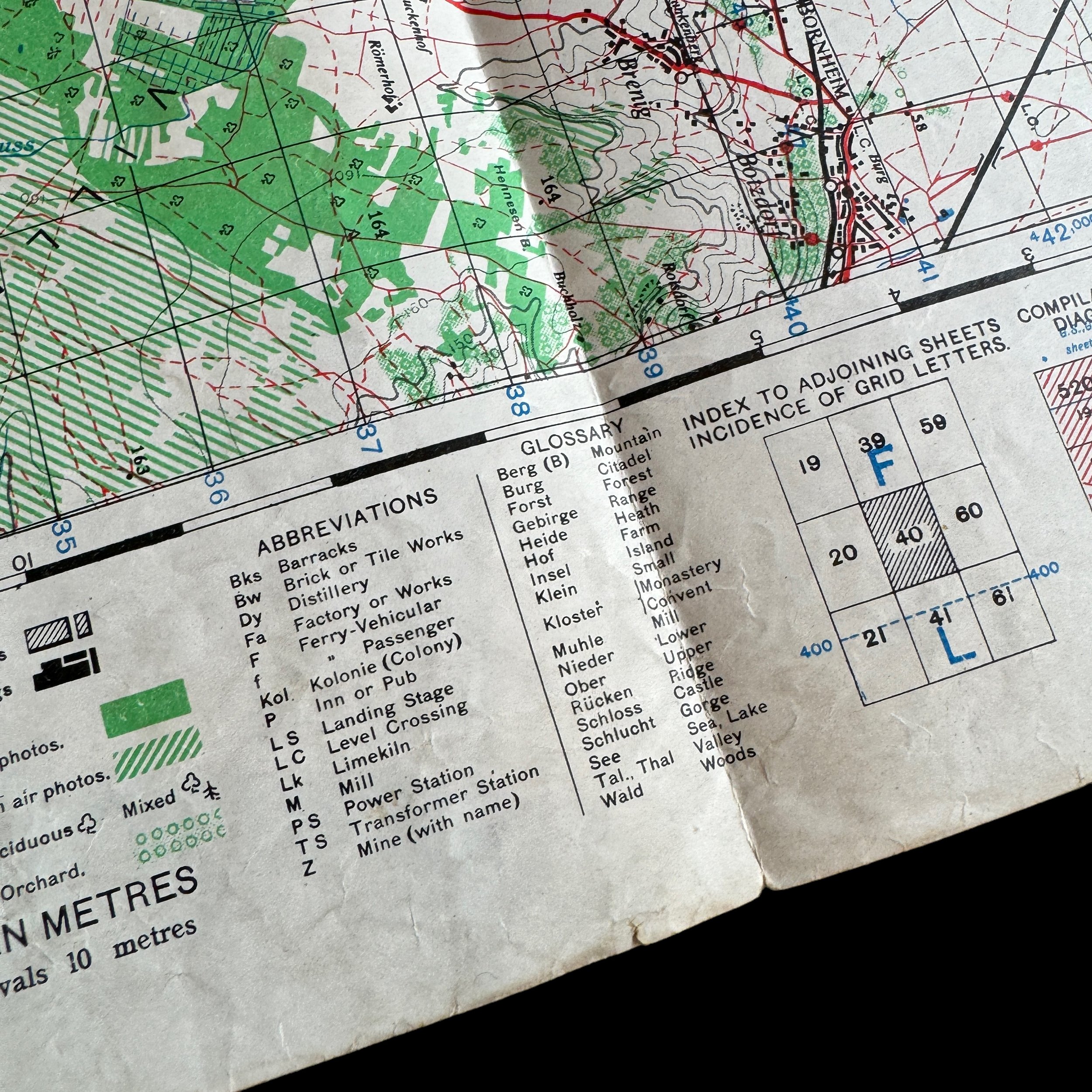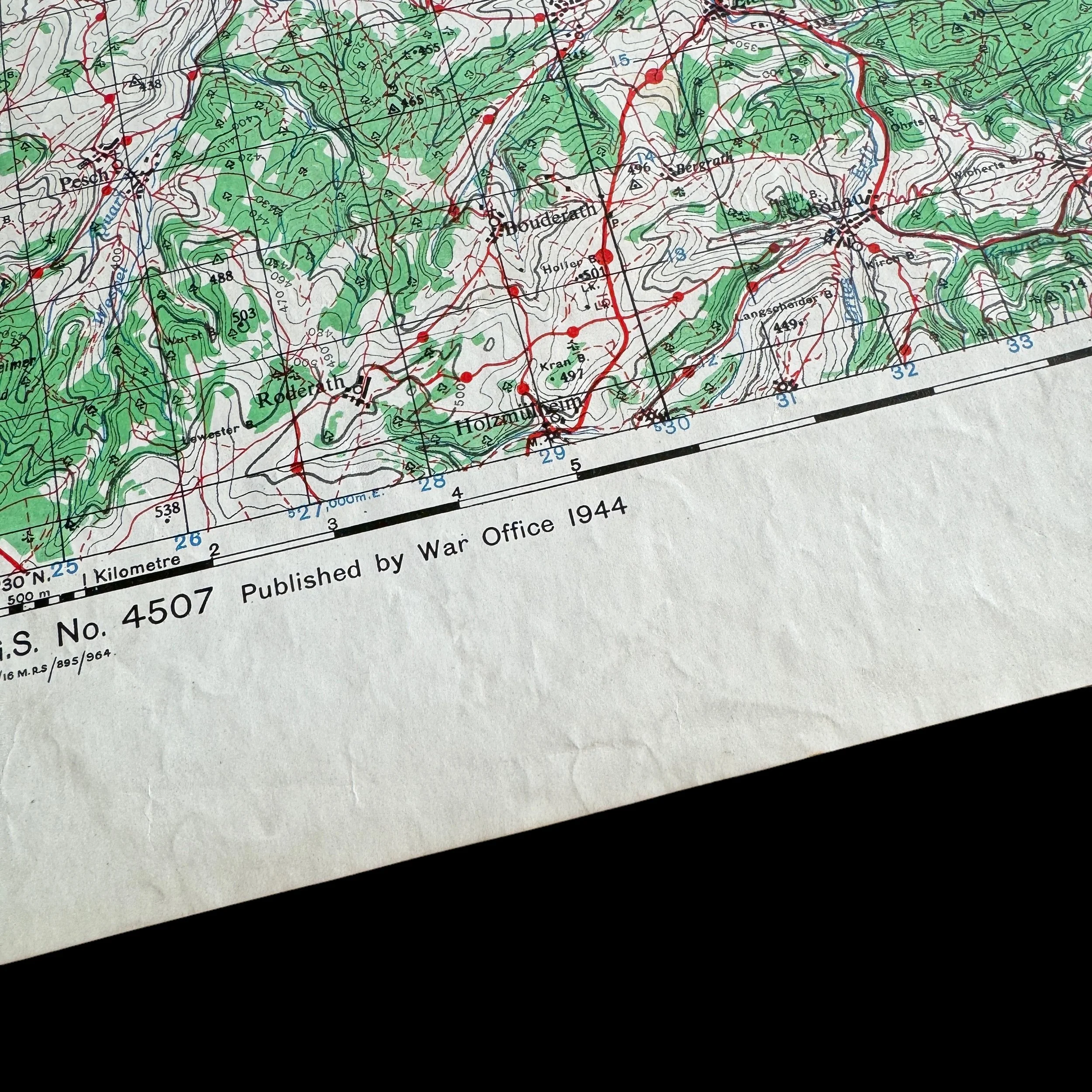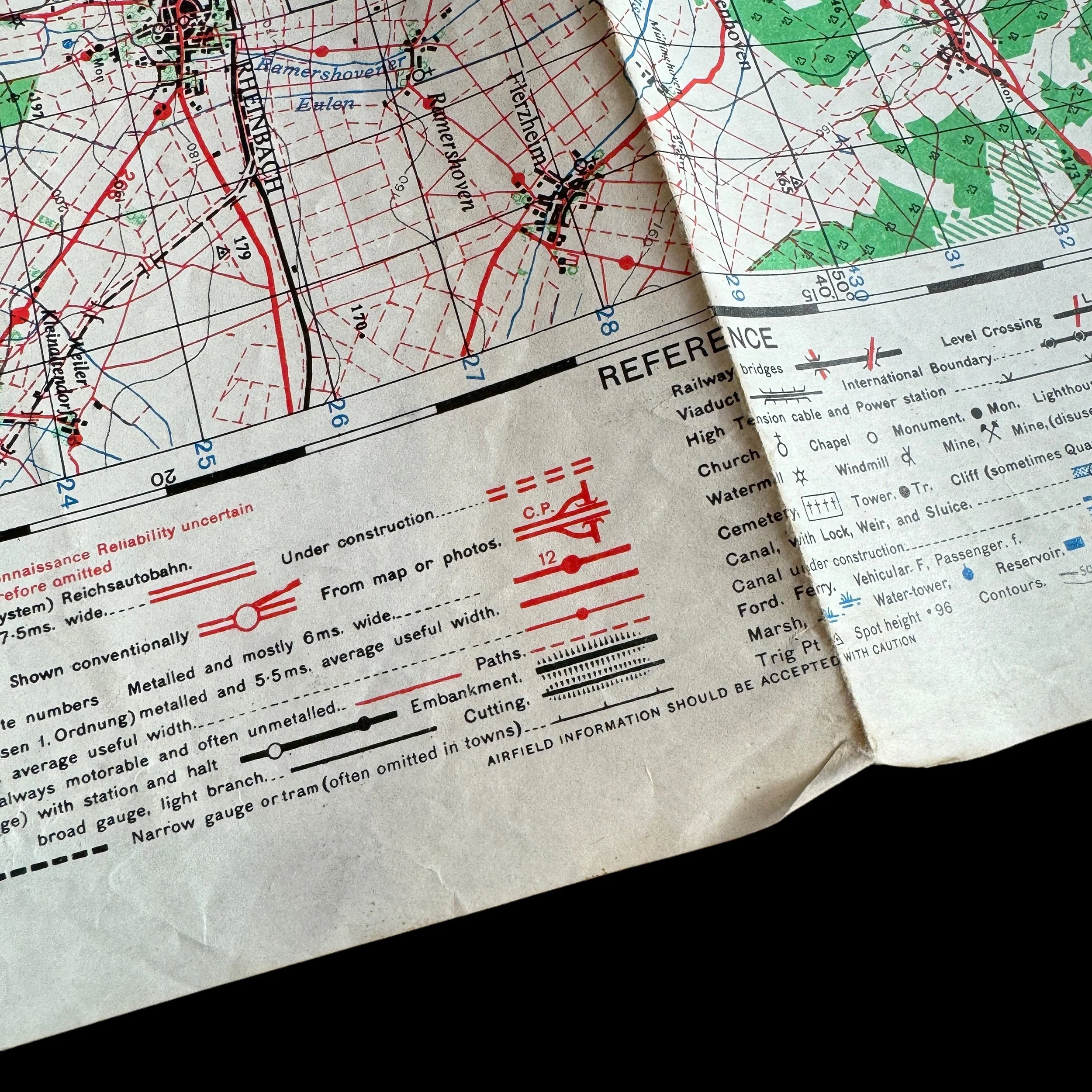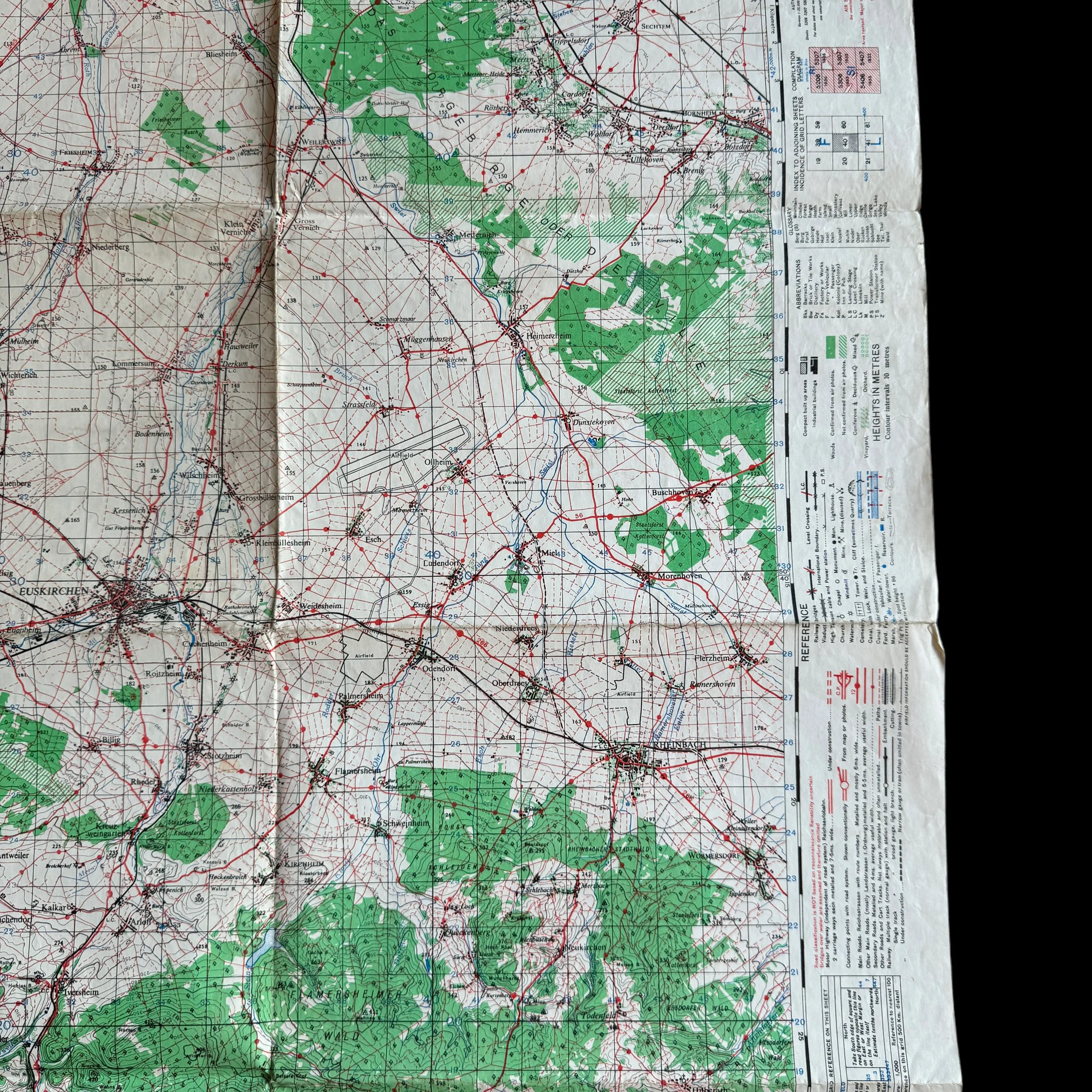WWII Operation Lumberjack Erft River Crossing Capture of Euskirchen 12th Army Group U.S. General of the Army Omar Bradley Infantry Combat Map





































WWII Operation Lumberjack Erft River Crossing Capture of Euskirchen 12th Army Group U.S. General of the Army Omar Bradley Infantry Combat Map
Comes with a hand-signed C.O.A.
This rare and museum-grade WWII U.S. Army map was used during Operation Lumberjack as U.S. General of the Army Omar Bradley's 12th Army Group launched Lumberjack on March 1st. Dated 1944 this combat map was used by U.S. Infantry soldier’s during their assault across the Erft River and into Euskirchen.
In the north, the First Army rapidly exploited bridgeheads over the Erft River, entering Euskirchen on 4 March and Cologne on the fifth. Cologne was in U.S. Army control by the seventh. The First Army then pushed towards the Ahr River valley, the likely point of retreat for what was left of the German Army's LXVI and LXVII Korps.
The U.S. Third Army met some resistance along the Siegfried Line and the Prüm and Kyll Rivers. On 4 March at Bitburg, the 5th Infantry Division cut through the German lines. Taking advantage of the breach, the Fourth Armored Division struck out on a 45-mile (72 km) drive to the Rhine in less than five days. While losing only 100 casualties, they cost the Germans 5,700 killed and wounded. The Fourth Armored barely missed the chance to capture a bridge at Urmitz.
While moving towards the Ahr, the U.S. 9th Armored Division on the right flank of the First Army had moved swiftly towards the Rhine. The closer the division got to the Rhine, the more quickly it advanced. The speed of their movement towards the Rhine surprised the Germans. About 20 kilometres (12 mi) upstream from Bonn, they unexpectedly found the Ludendorff railroad bridge still standing.
The Erft River Crossing and the Battle for Euskirchen: Pivotal Moments in Operation Lumberjack
The final phase of World War II in Europe was marked by a series of rapid and decisive operations that aimed to penetrate the heart of Nazi Germany. Among these, Operation Lumberjack stands out for its strategic design to clear the west bank of the Rhine River, particularly targeting the capture of key locations such as Cologne, Bonn, and ultimately crossing the Erft River to secure Euskirchen. This operation, primarily involving American forces under the command of General Omar Bradley’s 12th Army Group, was crucial not only for its immediate tactical achievements but also for setting the stage for the Rhine crossings and the encirclement of the Ruhr Pocket. The assault across the Erft River and the battle for Euskirchen exemplify the intense combat and strategic maneuvers typical of this phase of the war.
Prelude to the Assault
By early 1945, the German Wehrmacht was retreating on all fronts. The Allies, having broken through the Siegfried Line, were poised to launch operations that would exploit the weakening German defenses. Operation Lumberjack was designed to seize the remaining territory held by the Germans on the west bank of the Rhine, particularly as this area provided a defensive shield for the industrial heartland of the Ruhr. The Erft River, a tributary of the Rhine running roughly parallel and to the west, represented a significant natural obstacle and a formidable line of German defense.
The Strategic Importance of the Erft River and Euskirchen
The Erft River was not merely a geographical barrier; it was fortified with bunkers, pillboxes, and trenches as part of Germany’s formidable Western defenses. German troops, though depleted, were prepared to defend these positions fiercely. The capture of this area was essential for the Allies to secure the left flank of their advance toward the Rhine and prevent any counter-attacks from disrupting the main thrust into Germany.
Euskirchen, located just beyond the Erft River, was a key transportation and logistics hub. Its capture would disrupt German military logistics and facilitate a rapid advance towards the Rhine, further isolating the Ruhr region. Hence, the town was heavily defended by elements of the German Army, who were well-aware of its strategic significance.
Crossing the Erft River
The operation to cross the Erft and advance into Euskirchen was marked by intense planning and reconnaissance. American units involved in this phase included divisions from both the First and Ninth Armies. The First Army, under Lieutenant General Courtney Hodges, was responsible for the main effort which included crossing the Erft.
The crossing itself was a meticulously coordinated assault involving infantry supported by artillery and armored units. The night before the planned crossing, American artillery unleashed a massive barrage intended to soften German defenses and disrupt their command and control capabilities. Engineers played a crucial role, rapidly deploying assault boats and temporary bridges to facilitate troop movements across the river under cover of darkness and continuous artillery support.
The Battle for Euskirchen
Once across the Erft, American forces encountered stiff resistance from German troops determined to hold Euskirchen. Urban combat ensued, with both sides suffering heavy casualties. The Americans made extensive use of armored units and close air support to target German strongpoints within the town. The fighting was characterized by its brutality and the destruction inflicted on Euskirchen, with much of the town being reduced to rubble due to constant shelling and bombing.
Despite the fierce defense, the German troops were increasingly demoralized and depleted, unable to effectively sustain their positions. Within a few days of intense fighting, Euskirchen was secured by the Allies. The capture of the town not only provided a strategic advantage but also dealt a significant psychological blow to the Germans, as it signaled the impending encirclement and isolation of the Ruhr.
The crossing of the Erft River and the subsequent battle for Euskirchen were critical components of Operation Lumberjack. These actions exemplified the Allies' ability to execute combined arms operations effectively and adapt to the challenges posed by fortified river crossings and urban combat. The success of these operations significantly hastened the collapse of German resistance in the West and contributed directly to the success of subsequent operations across the Rhine and into the heart of Germany. The capture of Euskirchen, in particular, demonstrated the relentless push of the Allied forces and their commitment to ending Nazi tyranny, setting the stage for the final battles in the European theater of World War II.